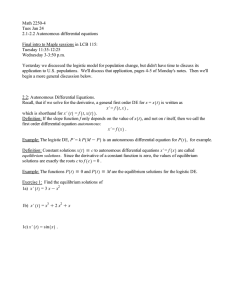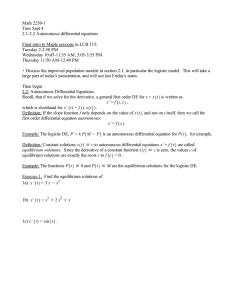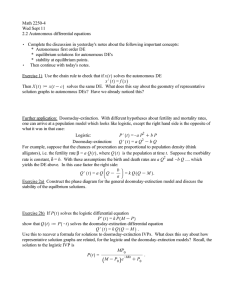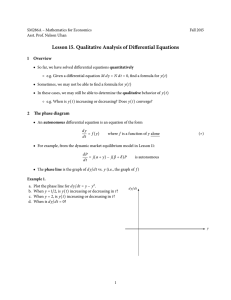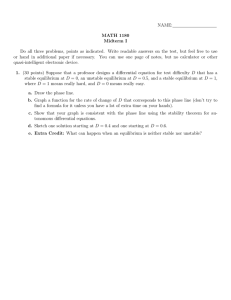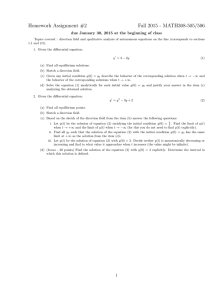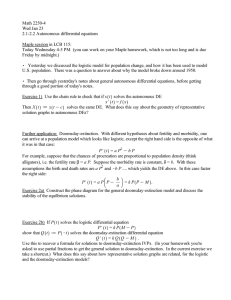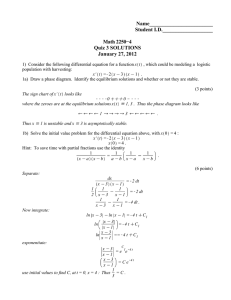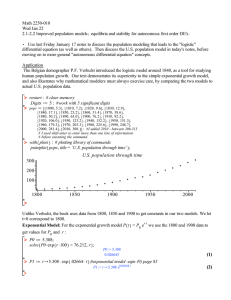Math 2280-01 Wed Jan 28 2.2: Autonomous Differential Equations. x
advertisement
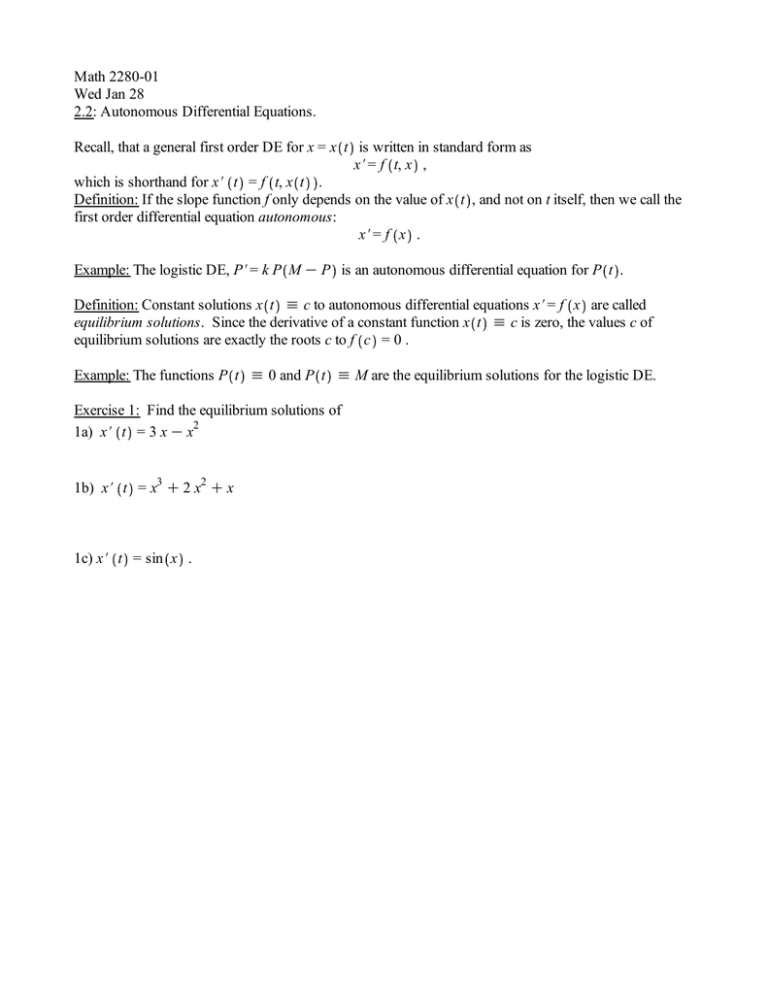
Math 2280-01 Wed Jan 28 2.2: Autonomous Differential Equations. Recall, that a general first order DE for x = x t is written in standard form as x#= f t, x , which is shorthand for x# t = f t, x t . Definition: If the slope function f only depends on the value of x t , and not on t itself, then we call the first order differential equation autonomous: x#= f x . Example: The logistic DE, P#= k P M K P is an autonomous differential equation for P t . Definition: Constant solutions x t h c to autonomous differential equations x#= f x are called equilibrium solutions. Since the derivative of a constant function x t h c is zero, the values c of equilibrium solutions are exactly the roots c to f c = 0 . Example: The functions P t h 0 and P t h M are the equilibrium solutions for the logistic DE. Exercise 1: Find the equilibrium solutions of 1a) x# t = 3 x K x2 1b) x# t = x3 C 2 x2 C x 1c) x# t = sin x . Def: Let x t h c be an equilibrium solution for an autonomous DE. Then · c is a stable equilibrium solution if solutions with initial values close enough to c stay close to c. There is a precise way to say this, but it requires quantifiers: For every e O 0 there exists a d O 0 so that for solutions with x 0 K c ! d, we have x t K c ! e for all t O 0 . · c is an unstable equilibrium if it is not stable. · c is an asymptotically stable equilibrium solution if it's stable and in addition, if x 0 is close enough to c , then t lim x t = c, i.e. there exists a d O 0 so that if x 0 K c ! d then /N lim x t = c . (Notice that this means the horizontal line x = c will be an asymptote to the solution graphs t /N x = x t in these cases.) Exercise 2: Use phase diagram analysis to guess the stability of the equilibrium solutions in Exercise 1. For (a) you've worked out a solution formula already, so you'll know you're right. For (b), (c), use the Theorem on the next page to justify your answers. 2a) x# t = 3 x K x2 2b) x# t = x3 C 2 x2 C x 2c) x# t = sin x . Theorem: Consider the autonomous differential equation x# t = f x v with f x and f x continuous (so local existence and uniqueness theorems hold). Let f c = 0 , i.e. vx x t h c is an equilibrium solution. Suppose c is an isolated zero of f, i.e. there is an open interval containing c so that c is the only zero of f in that interval. The the stability of the equilibrium solution c can is completely determined by the local phase diagrams: sign f : KKKK0 CCC 0 )))c/// 0 c is unstable sign f : CCC 0 KKKK 0 ///c))) 0 c is asymptotically stable sign f : CCC 0 CCC 0 ///c/// 0 c is unstable (half stable) sign f :KKKK0 KKKK 0 )))c))) 0 c is unstable (half stable) You can actually prove this Theorem with calculus!! (want to try?) Here's why! Exercise 3) Use the chain rule to check that if x t solves the autonomous DE x# t = f x Then X t d x t K c solves the same DE. What does this say about the geometry of representative solution graphs to autonomous DEs? Have we already noticed this? Further application: Doomsday-extinction. With different hypotheses about fertility and mortality rates, one can arrive at a population model which looks like logistic, except the right hand side is the opposite of what it was in that case: Logistic: P# t =Ka P2 C b P Doomsday-extinction: Q # t = a Q2 K b Q For example, suppose that the chances of procreation are proportional to population density (think alligators or crickets), i.e. the fertility rate b = a Q t , where Q t is the population at time t. Suppose the morbidity rate is constant, d = b. With these assumptions the birth and death rates are a Q2 and Kb Q .... which yields the DE above. In this case factor the right side: b Q# t = a Q Q K = k Q QKM . a Exercise 4a) Construct the phase diagram for the general doomsday-extinction model and discuss the stability of the equilbrium solutions. Exercise 4b) If P t solves the logistic differential equation P# t = k P M K P show that Q t d P Kt solves the doomsday-extinction differential equation Q# t = k Q Q K M . Use this to recover a formula for solutions to doomsday-extinction IVPs. What does this say about how representative solution graphs are related, for the logistic and the doomsday-extinction models? Recall, the solution to the logistic IVP is MP0 P t = . M K P0 eKMkt C P0 Exercise 5: Use your formula from the previous exercise or work the separable DE from scratch, to transcribe the solution to the doomsday-extinction IVP x# t = x x K 1 x 0 =2. Does the solution exist for all t O 0 ? (Hint: no, there is a very bad doomsday at t = ln 2.


